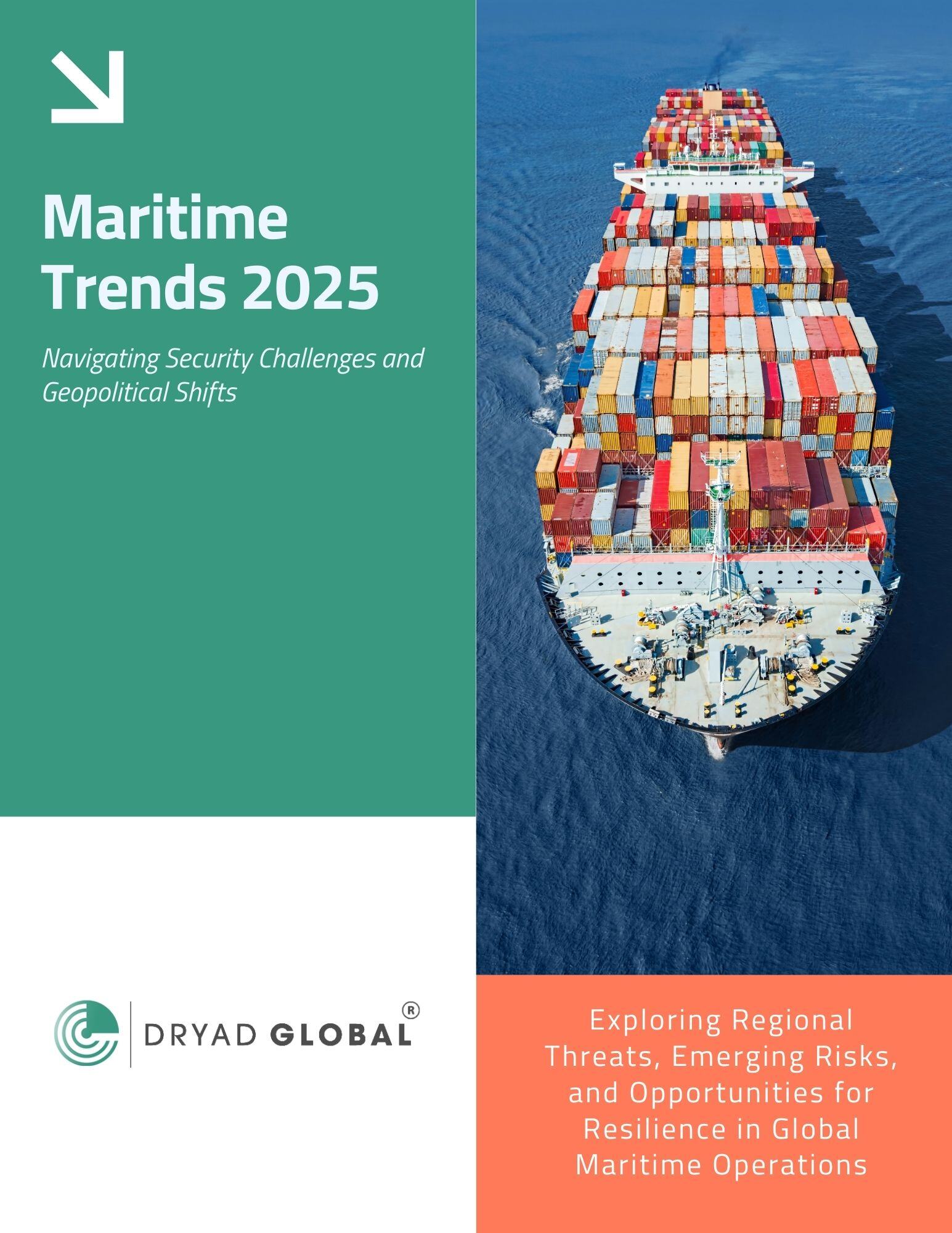4 min read
METIS INSIGHTS: Maritime Trends for 2025: Navigating Security Challenges and Geopolitical Shifts
By: Dryad Global on January 16, 2025 at 8:00 AM

Dryad Global's latest analysis, Maritime Trends for 2025: Navigating Security Challenges and Geopolitical Shifts, offers crucial insights into the emerging risks and opportunities shaping the maritime industry in the coming year.
Covering a broad range of topics—from cybersecurity threats and piracy hotspots to geopolitical tensions in key regions like the South China Sea and the Mediterranean—this report is an essential resource for maritime professionals, journalists, and policymakers. It provides expert perspectives on critical issues such as:
•The resurgence of piracy in the Indian Ocean.
•Escalating geopolitical risks in the Black Sea and South China Sea.
•Sophisticated cybersecurity challenges confronting the maritime sector.
•The impact of socio-economic instability on maritime crime and migration.
Top Maritime Security Questions for 2025: Key Trends and Challenges Explained
- What are the key maritime security challenges expected in 2025 across regions like the Indian Ocean, Red Sea, and Gulf of Guinea?
Explore the resurgence of piracy, geopolitical tensions, and shifting international naval support impacting global maritime trade.
- How will geopolitical tensions in the South China Sea and Black Sea influence global shipping routes and maritime trade in 2025?
Learn about the risks posed by regional conflicts, airstrikes, WBIEDs, and electronic warfare on maritime logistics.
- What cybersecurity threats will the maritime sector face in 2025, and how can organizations strengthen their defenses?
Discover the rise of AI-driven cyberattacks, ransomware, and vulnerabilities in operational technology targeting maritime infrastructure.
- How will socio-economic factors and regional instability, such as piracy in the Indian Ocean and smuggling in the Caribbean, shape maritime security trends in 2025?
Understand the root causes and implications of maritime crime and migration on global security and trade.
- What impact will policy changes and international relations have on maritime security in regions like the Mediterranean and the Gulf of Aden?
Analyze how shifts in naval strategies, air support, and political alliances will affect maritime operations and stability.
Executive Summary:
In the Indian Ocean along the East African coast, a resurgence of piracy is anticipated in 2025, facilitated by favorable weather conditions and a security vacuum left by the withdrawal of U.S. and EU naval forces. This follows recent pirate activities, including the use of hijacked fishing vessels as motherships, suggesting an increase in hijackings for ransom. Despite the Indian Navy's role as an effective deterrent, the situation might escalate without sustained international naval support. In the Red Sea and Gulf of Aden, the security environment is expected to remain unchanged, with Houthi attacks continuing, albeit with reduced effectiveness after the departure of an Iranian support vessel. The U.S. plans to shift from naval to air support, while EUNAVFOR offers limited escorts. Israeli airstrikes on Yemeni infrastructure could temporarily disrupt Houthi operations, yet without significant policy changes, their long-term threat may persist.
The Mediterranean faces heightened security volatility due to Israeli military operations and the collapse of the Assad regime, potentially leading to civil war in Syria. Hezbollah's supply routes have been disrupted, which might force them into new alliances or reduce their military capabilities. The implementation of Sharia law by Hayat Tahrir al-Sham could impact maritime trade negatively due to reduced infrastructure investment and increased security concerns.
In the Caribbean, instability in Haiti is driving maritime migration, smuggling, and crime, with Russian military exercises further adding to regional tensions. U.S. policy shifts on deportation could strain maritime resources and international relations, while China's increasing influence might reshape logistics and security around key maritime infrastructure.
The Black Sea region is poised for severe risks to shipping due to the ongoing conflict between Ukraine and Russia, involving airstrikes, WBIEDs, and electronic warfare. Efforts to clear sea mines by regional navies may reduce one aspect of the threat, but ceasefire negotiations are unlikely to ease tensions as both nations continue strategic maritime operations.
In the Gulf of Guinea, piracy has decreased, yet the underlying socio-economic factors that fuel piracy persist, with the main threat being illegal boardings at ports. Political stability from upcoming elections could influence maritime security alongside the potential spread of Sahelian terrorism to coastal states.
The South China Sea is poised to become a geopolitical hotspot, with potential shipping disruptions due to rising tensions between China, the United States, and regional allies. Finally, in 2025, the global maritime sector will face sophisticated cybersecurity threats such as AI-driven attacks, ransomware, and operational technology vulnerabilities, as well as state-sponsored cyber operations, requiring the industry to strengthen its defenses to secure operations in an increasingly digital and interconnected environment.
Related Posts
Maritime Security Intelligence Brief – Week of 7..
As geopolitical tensions and regional instabilities continue to shape the global maritime..
Maritime Security Intelligence Brief – Week of 21..
As geopolitical tensions and regional instabilities continue to shape the global maritime..
South East Asia - Straits of Malacca
Complex and Challenging The maritime security picture in South-East Asia is a complex interplay of..





